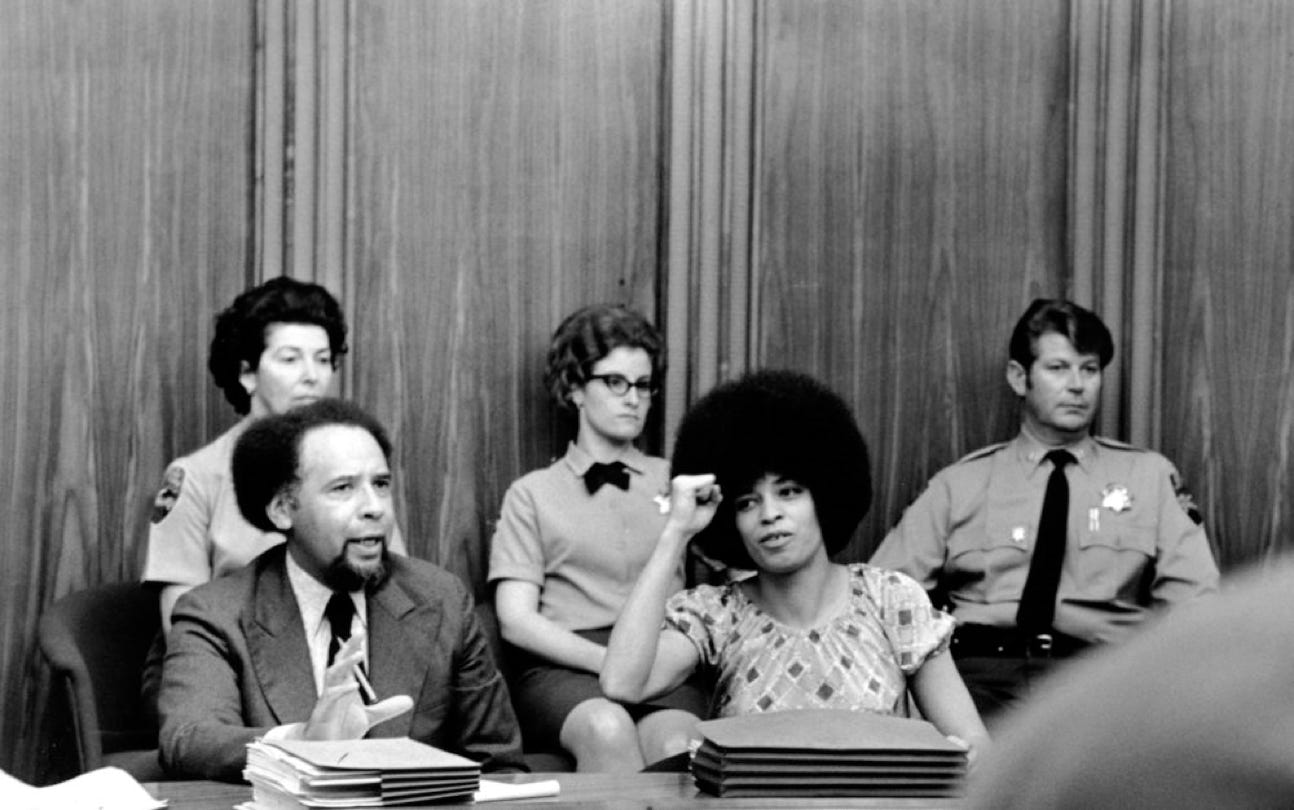EIC

Bethel
Equity &
Inclusion
Black History
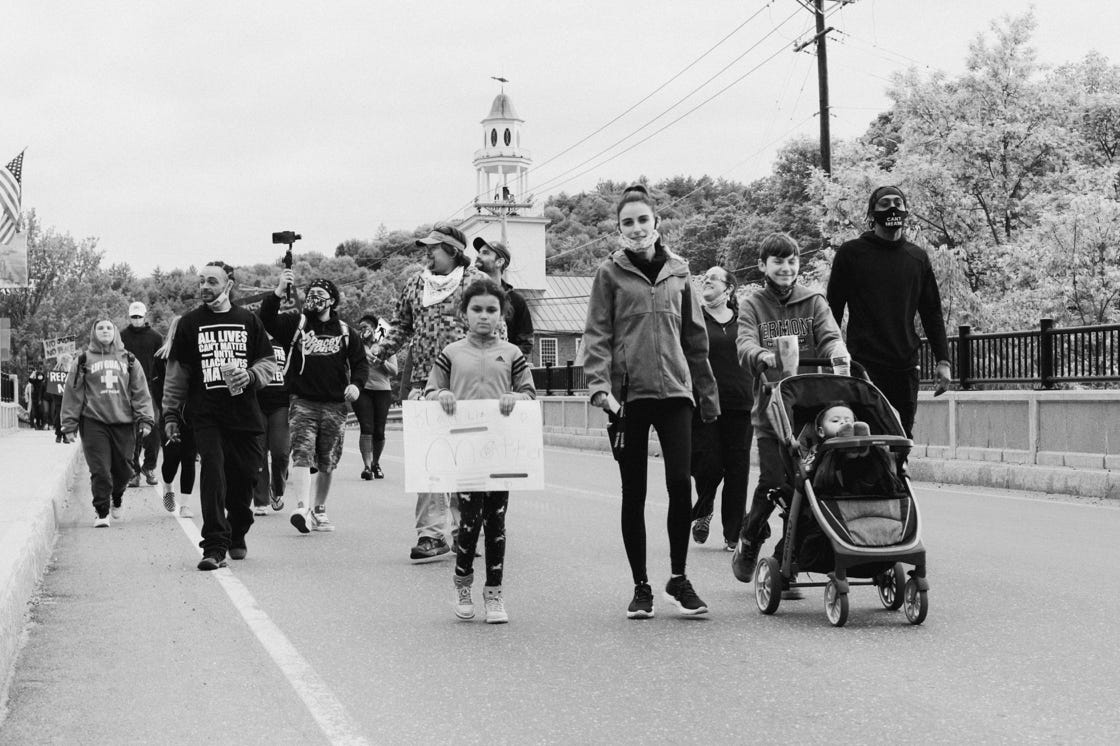

EIC

Bethel
Equity &
Inclusion
Black History


Shirley Chisholm was the first Black woman elected to the United States Congress. Chisholm represented New York's 12th congressional district centered in the Bedford–Stuyvesant neighborhood of Brooklyn for seven terms from 1969 to 1983.
In 1972, she became the first Black candidate for a major-party nomination for President of the United States, and the first woman to run for the Democratic Party's nomination.
Chisholm began her professional career as a teacher. She served as director of the Hamilton-Madison Child Care Center until the late 1950s, then as an educational consultant for New York City’s Bureau of Child Welfare. In Congress, she worked on the Education and Labor Committee and helped form the Black Caucus. Chisholm was also a vocal opponent of the draft.
In 2015, Chisholm was posthumously awarded the Presidential Medal of Freedom by President Barack Obama.
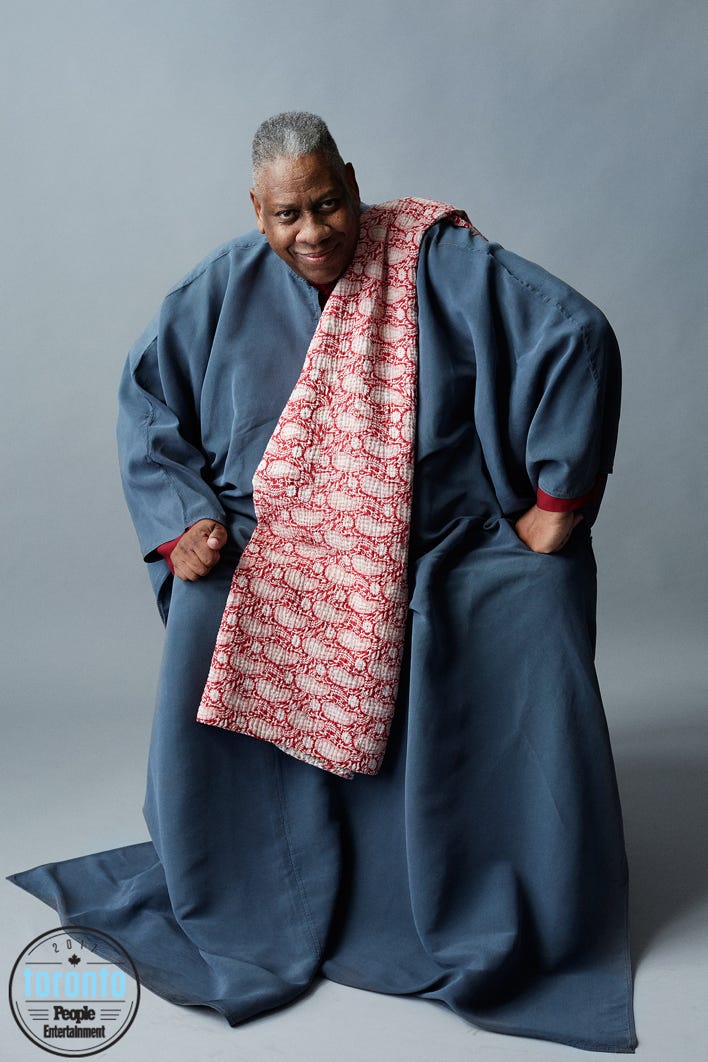
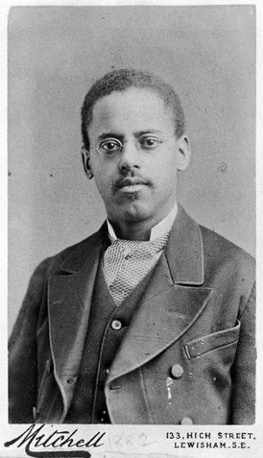
Lewis Howard Latimer (September 4, 1848 – December 11, 1928) was an inventor and draftsman best known for his contributions to the patenting of the light bulb and the telephone. Over the course of his career as a draftsman, Latimer worked closely with Thomas Edison and Alexander Graham Bell, in addition to designing his own inventions.
Latimer was the youngest of four children born to George and Rebecca Latimer, who had escaped from enslavement in Virginia six years before his birth. Captured in Boston and brought to trial as a fugitive, George Latimer was defended by abolitionists Frederick Douglass and William Lloyd Garrison. He was eventually able to purchase his freedom, with the help of a local minister, and began raising a family with Rebecca in nearby Chelsea, MA. George disappeared shortly after the Dred Scott decision in 1857, possibly fearing a return to slavery.
After his father's departure, Latimer worked to help support his mother and family. In 1864, at the age of 16, Latimer lied about his age in order to enlist in the United States Navy during the Civil War. Returning to Boston after an honorable discharge, he accepted a menial position at the Crosby and Gould patent law office. He taught himself mechanical drawing and drafting by observing the work of draftsman at the firm.
Latimer designed a number of his own inventions, including an improved railroad car bathroom and an early air conditioning unit. He was directly involved with the invention of the telephone. Working with Bell, Latimer helped draft the patent for Bell's design of the telephone. He was also involved in the field of incandescent lighting, a particularly competitive field, working for Hiram Maxim and Edison.
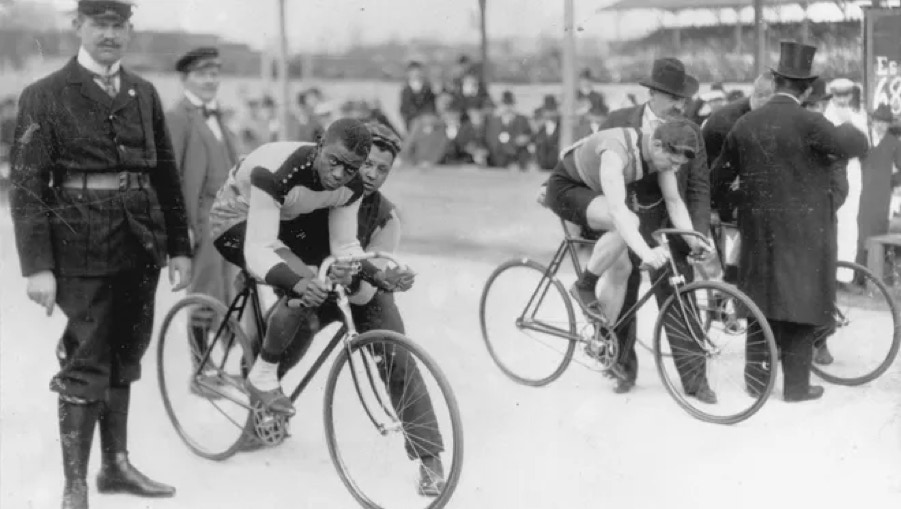
Sadie Tanner Mossell Alexander (January 2, 1898 – November 1, 1989), was the first Black woman in the U.S. to earn a doctorate degree (Ph.D.) in economics - when she was only 23 years old. A few years later in 1927, she was the first woman to receive a law degree from the University of Pennsylvania Law School, becoming the first Black woman to practice law in Pennsylvania.
Throughout Alexander’s long and fruitful career, she championed civil rights for marginalized groups, especially Black women, creating a path for today’s Black economists, lawyers, and policy practitioners. In 1946 she was appointed to the President's Committee on Civil Rights established by Harry Truman. In 1952 she was appointed to the city's Commission on Human Relations, serving through 1968. She was a founding member of the National Lawyers' Committee for Civil Rights Under Law in 1963 and she served on the board of the National Urban League for 25 years. U.S. President Jimmy Carter appointed her in 1979 to chair the decennial White House Conference on Aging, an honor that was later withdrawn by the Reagan administration.
George Washington was the founder of the town of Centralia, WA. Washington was born in Virginia. His father was enslaved and sold and taken from the area soon after Washington's birth. He was left with a white couple, the Cochrans, who raised him.
When he was four, the Cochrans moved west to Ohio and later Missouri. There, Washington became a skilled rifleman and taught himself to read. After the Cochrans petitioned the state of Missouri, he was given full rights as a citizen, except the right to vote. Fearing he might lose his freedom after the passage of the Compromise of 1850, Washington moved the Cochrans and himself over the Oregon Trail. He is remembered as a leading Black pioneer of the Pacific Northwest.

Photo by Nick Keating

Bayard Rustin
Bayard Rustin was the man behind the March on Washington and one of the most consequential architects of the civil rights movement. Informed by Ghandi, Rustin imagined how nonviolent civil resistance could be used to dismantle segregation in the United States organized around the idea for years and eventually introduced it to Dr. Martin Luther King Jr. Rustin organized Freedom Rides, and helped to organize the Southern Christian Leadership Conference to strengthen Martin Luther King Jr's teaching about nonviolence. However, Rustin's identity as a gay man made him a target, obscured his rightful status and made him feel forced to choose, again and again, which aspect of his identity was most important.
For an excellent listen on the Life and Times of Bayard Rustin, click here:
https://www.npr.org/2022/01/12/1072465899/bayard-rustin-the-man-behind-the-march-on-washington-2021


Pauli Murray
Pauli Murray was an American civil rights activist, lawyer, women's rights activist, Episcopal priest, and author.
In 1940, Murray sat in the whites-only section of a Virginia bus with a friend, and they were arrested for violating state segregation laws. This incident, and her subsequent involvement with the socialist Workers' Defense League, led her to pursue her career goal of working as a civil rights lawyer. She enrolled in the law school at Howard University, where she was the only woman in her class. Murray graduated first in her class, but she was denied the chance to do post-graduate work at Harvard University because of her gender. She called such prejudice against women "Jane Crow." In 1965 she became the first African American to receive a Doctor of Juridical Science degree from Yale Law School.
Murray was appointed by President John F. Kennedy to serve on the 1961–1963 Presidential Commission on the Status of Women. In 1966, she was a co-founder of the National Organization for Women. Ruth Bader Ginsburg named Murray as a coauthor of a brief on the 1971 case Reed v. Reed, in recognition of her pioneering work on gender discrimination.
In 1973, Murray left academia for activities associated with the Episcopal Church. In 1977, the first year that any women were ordained by that church, Murray became the first African-American woman to be ordained as an Episcopal priest.
In current terms, Murray is understood to be transgender. In her twenties, she shortened her name at birth to the more androgynous Pauli. At the time of her arrest for the bus segregation protest in 1940, she gave her name as "Oliver" to the arresting officers. Murray pursued hormone treatments in the 1940s to correct what she saw as a personal imbalance. Rosalind Rosenberg, the author of the biography Jane Crow: The Life of Pauli Murray, said: "[During Pauli's life,] the term transgender did not exist and there was no social movement to support or help make sense of the trans experience. Murray's papers helped me to understand how her struggle with gender identity shaped her life as a civil rights pioneer, legal scholar, and feminist."
André Leon Talley (October 16, 1948 – January 18, 2022) was an American fashion journalist, stylist, creative director, and editor-at-large of Vogue magazine. He was the magazine's fashion news director from 1983 to 1987, its first Black male creative director from 1988 to 1995, and then its editor-at-large from 1998 to 2013.
Often regarded as a fashion icon, he was known for supporting emerging designers and advocating for diversity in the fashion industry. His capes, kaftans, and robes became his trademark look. Talley also served on the judging panel for America's Next Top Model (from Cycle 14 to Cycle 17). He additionally worked stints with Andy Warhol at Interview, Women's Wear Daily, W, Ebony and The New York Times. He once served as a stylist for United States President Barack Obama and First Lady Michelle Obama during their time in the White House.
Marshall "Major" Taylor (November 26, 1878 – June 21, 1932) was an American professional cyclist. He was born and raised in Indianapolis, where he worked in bicycle shops and began racing multiple distances in the track and road disciplines of cycling. Taylor turned professional in 1896 at the age of 18.
In 1898 and 1899, he set numerous world records in race distances ranging from the quarter-mile (0.4 km) to the two-mile (3.2 km). Taylor won the 1-mile sprint event at the 1899 world track championships to become the first African American to achieve the level of cycling world champion and the second Black athlete to win a world championship in any sport (following Canadian boxer George Dixon, 1890).
Throughout his career he challenged the racial prejudice he encountered on and off the track and became a pioneering role model for other athletes facing racial discrimination.
Paul Revere Williams was the first black architect to become a member of the American Institute of Architects in 1923, and in 1957 he was inducted as the AIA's first black fellow. When he began his career, he could find no black architects to be his role models or mentors.
Williams won an architectural competition at age 25, and three years later opened his own office. Known as an outstanding draftsman, he perfected the skill of rendering drawings "upside down." This skill was developed because in the 1920s many of his white clients felt uncomfortable sitting directly next to a Black man. He learned to draft upside down so that he could sit across the desk from his clients who would see his drafts right-side-up
By the time he died in 1980, Williams had created some 2,500 buildings, most of them in and around Los Angeles, but also around the globe. Williams designed the homes of numerous celebrities, including Frank Sinatra, Lucille Ball and Desi Arnaz, Lon Chaney, Barbara Stanwyck and Charles Correll. He also designed many public and private buildings. His buildings feature characteristics that were innovative when he used them in the 1920s through the '70s and are considered common practice now — like the patio as an extension of the house, and hidden, retractable screens.

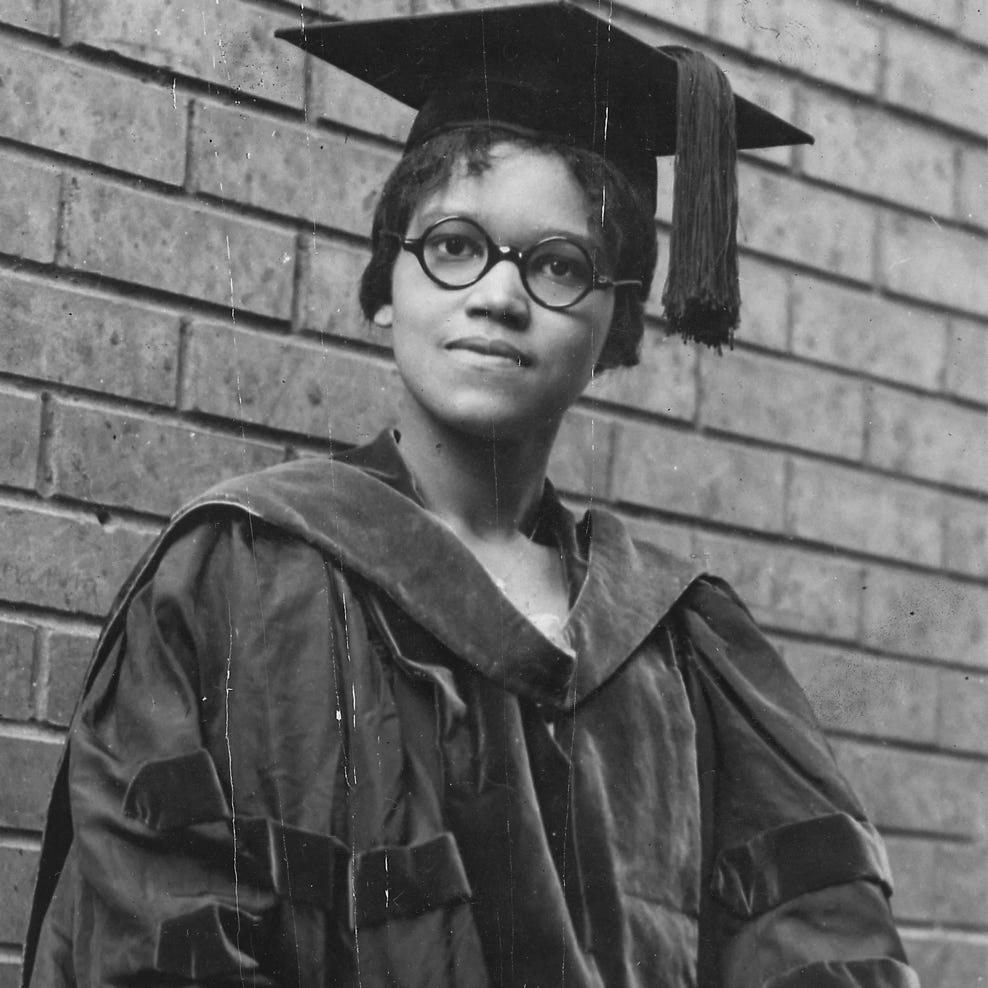

Nathan "Nearest" Green
was the first master distiller for Jack Daniel Distillery.
Around the mid-1800s, Green was enslaved by a firm known as Landis & Green, who “leant out” Nearest Green for a fee to Tennessee preacher Rev. Dan Call. Nearest was known as a skilled distiller who specialized in a process known as "sugar maple charcoal filtering" – also called the Lincoln County Process - which differentiates bourbon from Tennessee whiskey. This method – which some historians believe was inspired by the techniques of enslaved men and women who had used charcoal to filter water and purify foods in West Africa – gave Green’s whiskey a unique smoothness.
After emancipation, Call sold his distillery to Jack Daniel who had become Nearest Green's apprentice. Jack Daniel appointed Nearest Green to be the Jack Daniel Distillery’s first master distiller, and thus the first Black master distiller on record in the United States.
Sometime after 1881, Daniel moved his distillery to its current Cave Spring Hollow location, where several of Green’s children and grandchildren went to work for him. Nearest’s second-born and fourth-born sons, George and Eli, distilled whiskey on the Call Farm alongside Jack Daniel. Altogether, seven generations of Nearest Green’s family have worked for the Jack Daniel Distillery and continue to work there to this day.
In July 2017 "Uncle Nearest Premium Whiskey" became the first spirit named after a Black man and the first major spirits brand to be headed by an African-American woman, Fawn Weaver. Uncle Nearest is also the first American spirit brand with an all-female executive team.
In June 2020, the Nearest Green Distillery and the Jack Daniel Distillery created the Nearest Green School of Distilling at Motlow State Community College, which provides expertise and resources to African-Americans entering the spirits industry. In 2021, Uncle Nearest announced that Victoria Eady Butler would become the first African-American female whiskey master blender and lead distilling operations. Butler is a descendant of Nathan Green. On June 1, 2021, Uncle Nearest announced the formation of the Uncle Nearest Venture Fund, a $50 million initiative to invest in minority-founded and owned spirits brands.
The Freedom House Ambulance Service
was the first pre-hospital emergency care. In the 1960s, Pittsburgh PA, like most cities, was segregated by race. Police were the ones who responded to medical emergency calls. "Back in those days, you had to hope and pray you had nothing serious," recalls filmmaker and Hollywood paramedic Gene Starzenski, who grew up in Pittsburgh. "Because basically, the only thing they did was pick you up and threw you in the back like a sack of potatoes, and they took off for the hospital. They didn't even sit in the back with you." Things were more perilous in predominantly black neighborhoods, where people would wait longer for police transport.
Founded in 1967 to serve the predominantly Black neighborhood of Hill District of Pittsburgh, Freedom House Ambulance Service broke medical ground by training its personnel to previously unheard of standards of emergency medical care for patients en route to hospitals. The majority of staff were Black. The paramedic training and ambulance design standards pioneered in the Freedom House Ambulance Service would set the standard for emergency care nationally and even internationally.
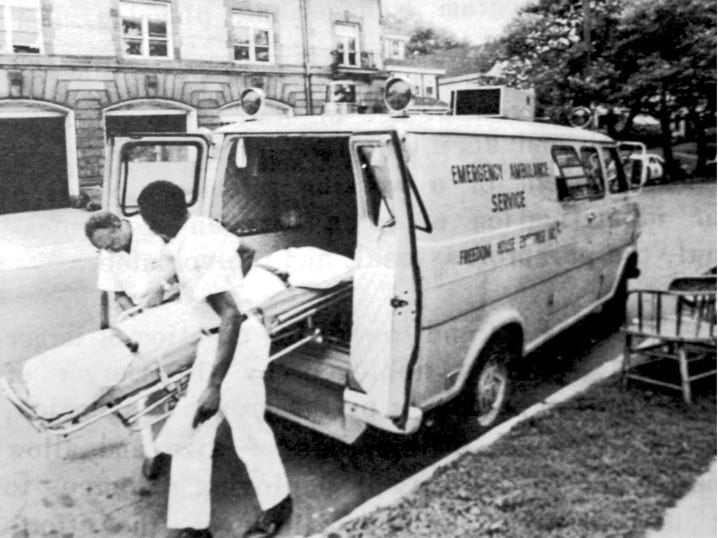
Willie O'Ree
changed hockey forever on Jan. 18, 1958. In the midst of the fight to end Jim Crow and the birth of the civil rights movement, Willie - the descendant of escaped enslaved people - became the first black player to skate in a National Hockey League game. He played 45 games in the NHL and then 22 years of minor league hockey. Later, Willie sold cars, managed fast food restaurants, and worked security at a hotel. In 1994 when he was 60 years old, he was asked to become the NHL's diversity ambassador.
To learn more, check out the Willie O’Ree documentary website https://www.williedoc.com/
You can also watch the doc on ESPN2 and Amazon Prime Video.
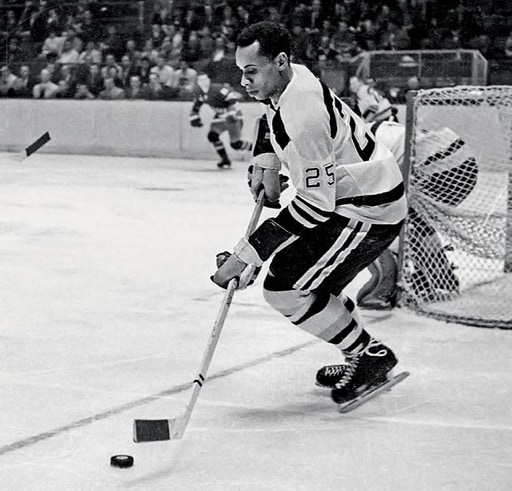
The Grammy Award for Best Rap Performance was first presented in 1989 at the 31st Annual Grammy Awards. However, many of the first nominees boycotted the Grammy awards that year because the category was barred from the televised awards.
The inaugural Best Rap Performance nominees included:
DJ Jazzy Jeff & The Fresh Prince for "Parents Just Don't Understand"
J. J. Fad for "Supersonic"
Kool Moe Dee for "Wild Wild West"
LL Cool J for "Going Back to Cali"
Salt-n-Pepa for "Push It"
When the show's producers decided that the only rap award would be announced during the non-televised portion of the show due to "time constraints," Will Smith (the Fresh Prince) said “we chose to boycott.” Rap was still considered a fringe force, fighting not only for its place at the Grammy Awards but also for acknowledgement as a musical genre. He called the idea of the afternoon award a “slap in the face. … You go to school for 12 years, they give you your diploma and they deny you that walk down the aisle.” Salt-n-Pepa issued a public statement that said: "If they don't want us, we don't want them."
DJ Jazzy Jeff and Will Smith, LL Cool J and Salt-n-Pepa boycotted the event. Adding to the controversy surrounding the category, some members of the rap community believed artists such as Big Daddy Kane, KRS-One, and N.W.A (whose debut album Straight Outta Compton "launched gangsta rap") should have received a nomination.
The first award for Best Rap Performance went to DJ Jazzy Jeff & The Fresh Prince.
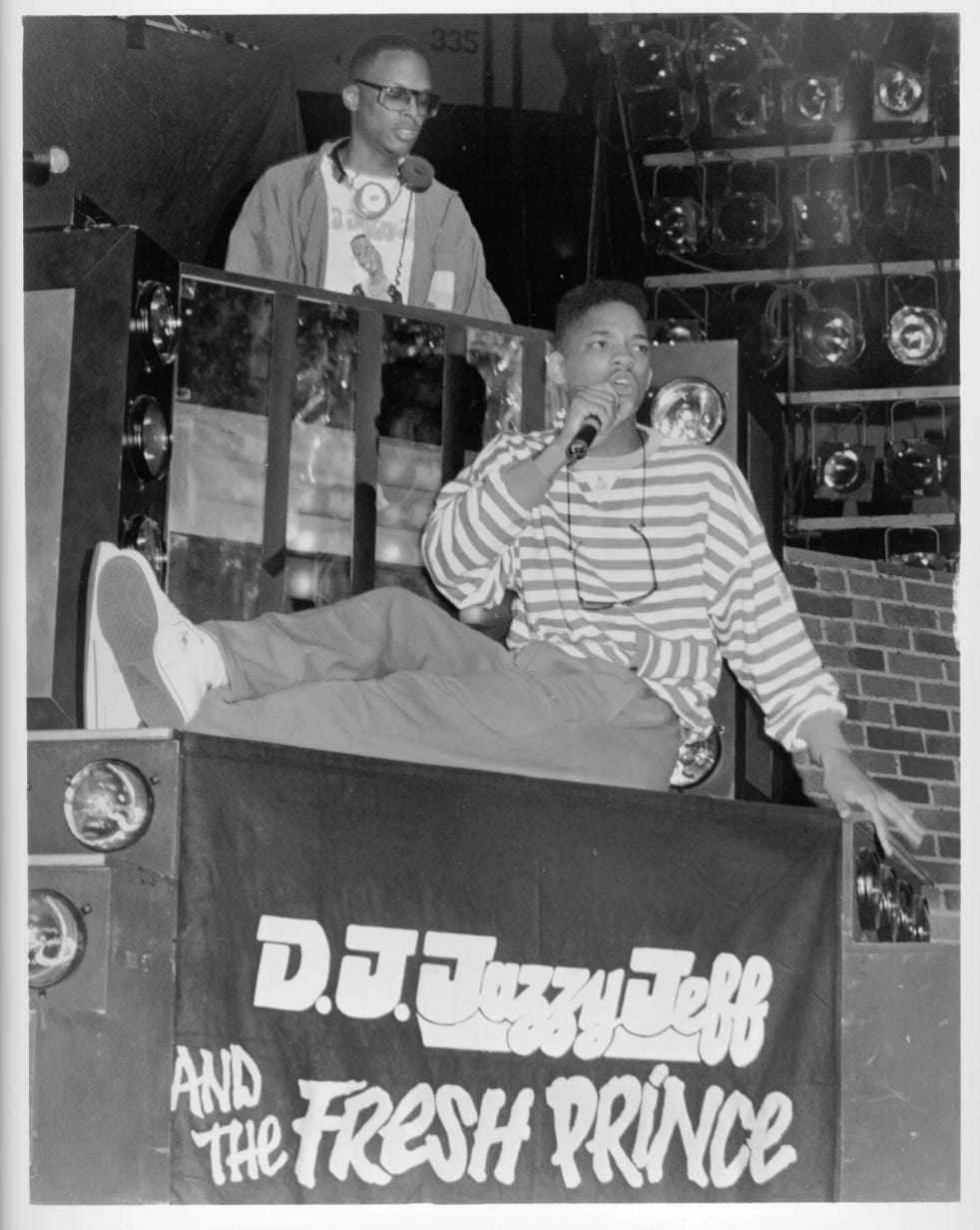
Willie Simms was born in 1870 near Augusta, GA. He was a Black horse jockey who began racing in 1887 and was one of the most successful to use the short stirrup that gave the rider a crouching posture.
En route to winning the United States riding title in 1893 and 1894, Simms won back-to-back Belmont Stakes. The following year, he raced in England where he became the first American jockey to win with an American horse in that country. In America, Simms won the 1896 Kentucky Derby in its first time as a one and a quarter mile race. He repeated as the Derby winner in 1898, and went on to take the Preakness Stakes a few weeks later, making him the only Black jockey to win all of the Triple Crown races.
During a brilliant 14-year career, Simms rode some of the great thoroughbred racehorses of the day such as two-time Horse of the Year winner, Henry of Navarre.
He finished his riding career with 1,125 wins and in 1977 was elected to the National Museum of Racing and Hall of Fame. He was national riding champion in 1893 and 1894. Willie Simms died February 26, 1927 in Asbury, New Jersey.

Ernestine Eckstein helped steer the U.S. Lesbian and Gay rights movement in the 1960s.
Born in South Bend, Indiana, Ecklestein had experience working with civil rights organizations such as the NAACP as a college student in Indiana before moving to Manhattan in the early 1960s. There, she was a member of the Congress of Racial Equality (CORE) and in 1964 became the vice president of the New York Chapter of Daughters of Bilitis (the first lesbian civil and political rights organization in the United States).
Ecklestein was an influential leader who urged lesbian and gay rights activists to engage in more direct action efforts instead of negotiating acceptance from medical professionals. In 1965, she was a leader of the gay and lesbian picket line in front of the White House (pictured above) and in the 1970s she became involved in the black feminist movement, in particular the organization Black Women Organized for Action (BWOA).
Ecklestein's understanding of, and work in, the Civil Rights Movement influenced the importance of public protest in the lesbian and gay movement for decades to come.
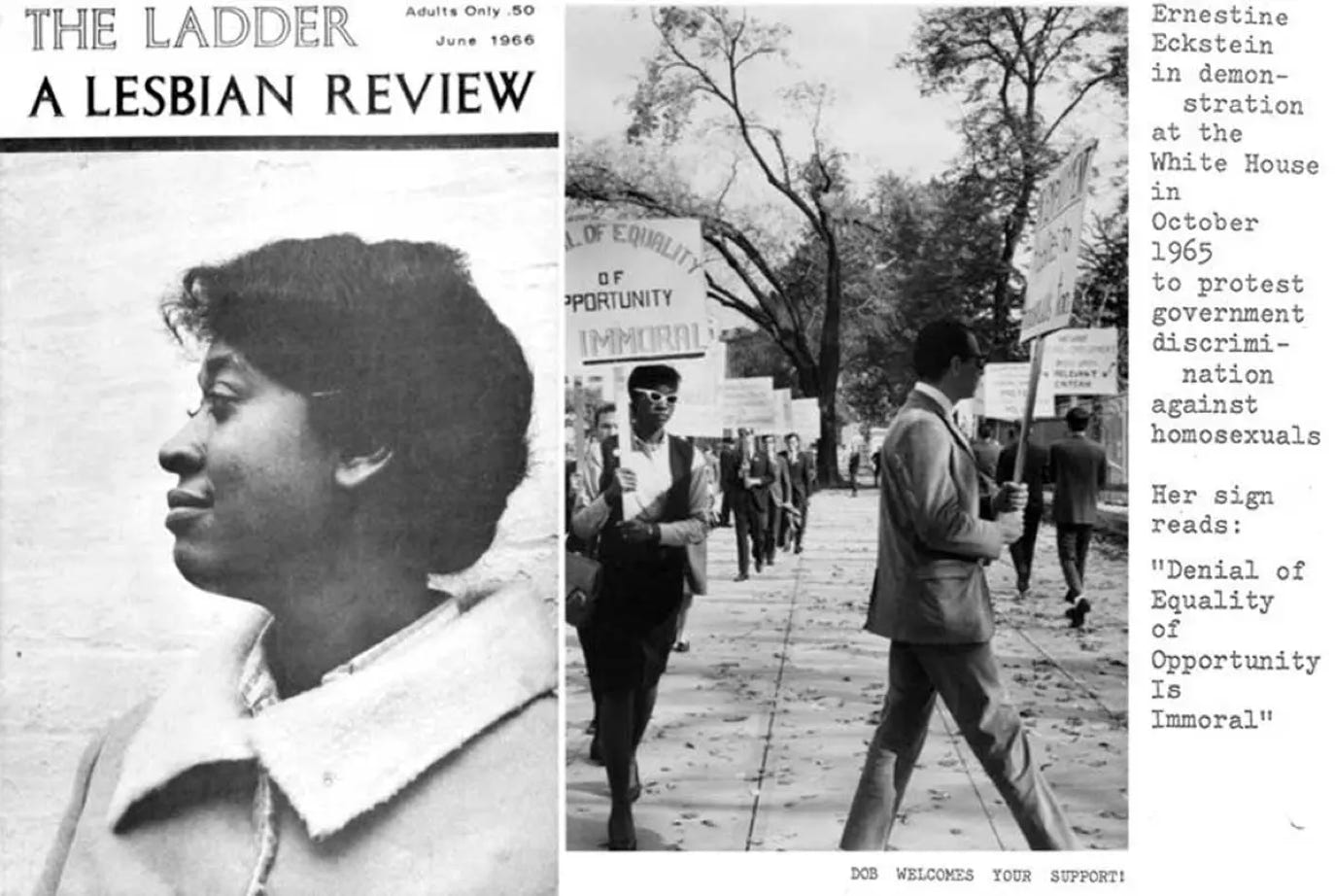
Garrett A. Morgan (1877–1963), American inventor and community leader.
Garret Morgan invented the Gas Mask and improved Traffic Lights so that what we see today is essentially what he designed. Both inventions were born out of life experience in Cleveland, OH.
In 1916 his gas mask saved eight people trying to save miners caught in a natural gas explosion beneath Lake Erie. He invented and patented the “three position traffic signal” in 1923 after witnessing a traffic incident in which several people were killed.
Morgan was the child of a Confederate General and a former slave woman. He had a limited formal education, but in a letter to Cleveland’s mayor in 1916, he wrote: “I am not a well educated man; however, I have a Ph.D. from the school of hard knocks and cruel treatment.
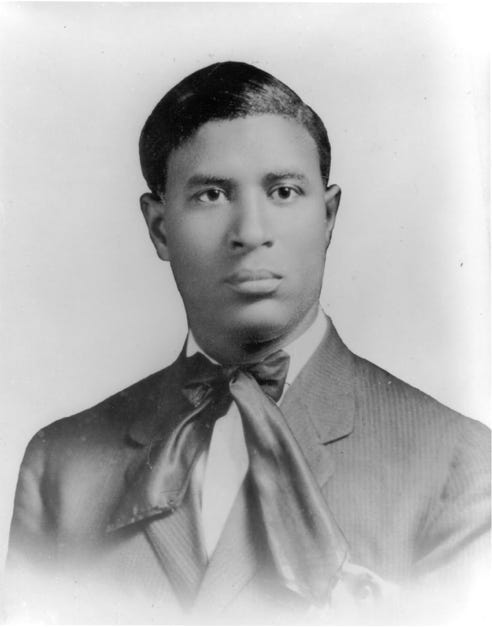
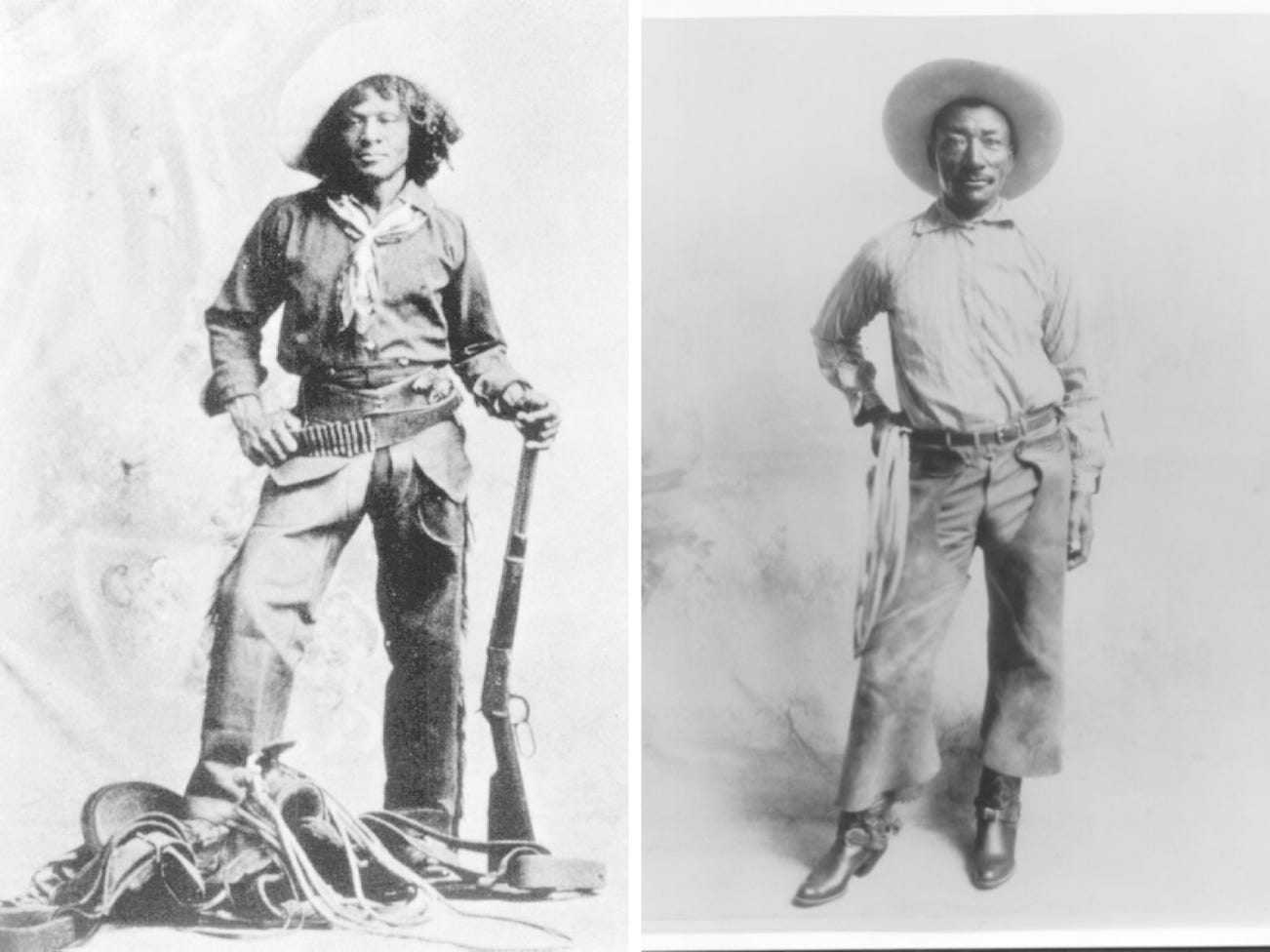
Did you know that one in four cowboys were black despite the stories told in popular books and movies? White Americans seeking cheap land—and sometimes evading debt in the United States—began conquest of the Mexican territory of Texas during the first half of the 19th century. Though the Mexican government opposed slavery, Americans brought enslaved Black people with them as they settled the frontier and established cotton farms and cattle ranches. By 1825, enslaved Black people accounted for nearly 25 percent of the Texas settler population. By 1860, fifteen years after it became part of the Union, that number had risen to over 30 percent.
White Texas ranchers depended on the people they enslaved to maintain their land and cattle herds. In doing so, Black people developed the skills of cattle tending (breaking horses, pulling calves out of mud and releasing longhorns caught in the brush, to name a few) that would render them invaluable to the Texas cattle business in the post-war era. During reconstruction, the cowboy industry generally treated Black men equally to white men in terms of pay and responsibilities, although discrimination persisted, though to a lesser extent than in other industries of the time.
Black Cowboys also made up a significant portion of law enforcement at the time - called "rangers." In fact, it's believed that the real “Lone Ranger” was inspired by an African American man named Bass Reeves. Reeves had been born enslaved but escaped West during the Civil War where he lived in what was then known as "Indian Territory." He eventually became a Deputy U.S. Marshal, was a master of disguise, an expert marksman, had a Native American companion, and rode a silver horse.
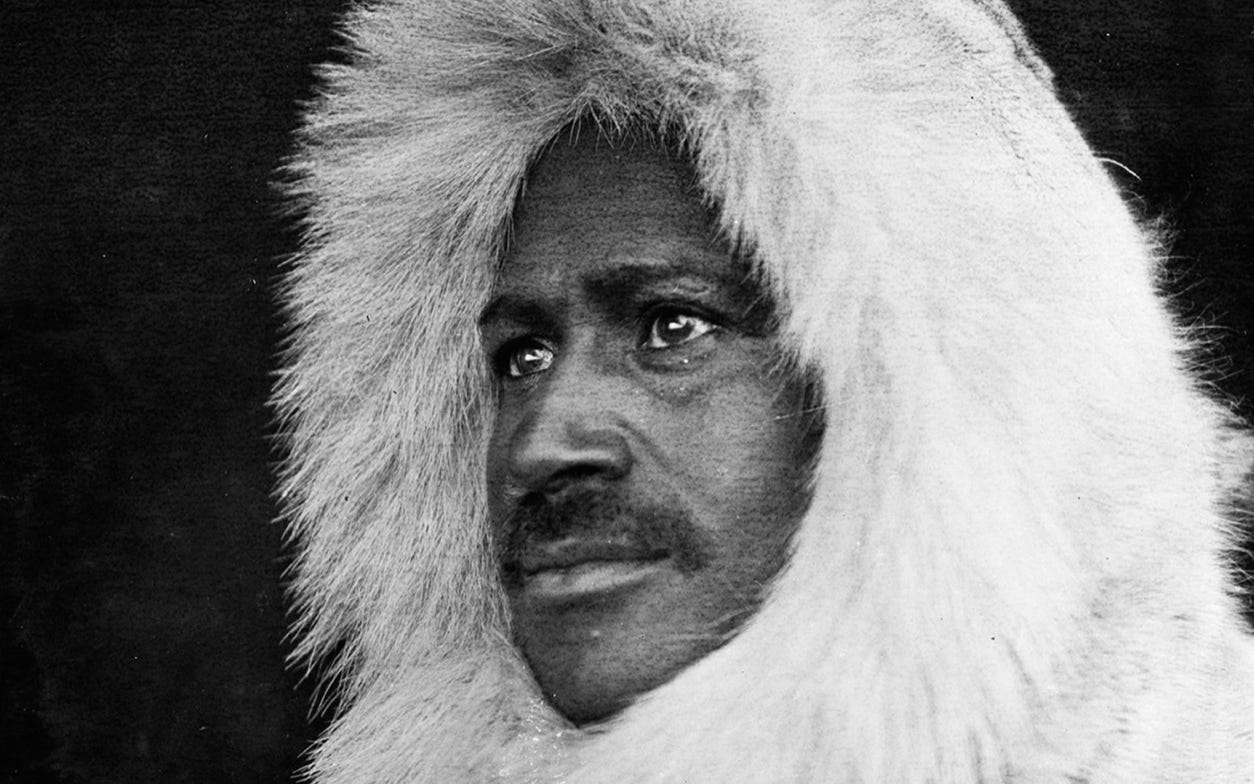
Matthew Alexander Henson (August 8, 1866 – March 9, 1955) was an American explorer who took seven voyages to the Arctic over a period of nearly 23 years. He is best known for his participation in the 1908–1909 expedition that reached the geographic North Pole on April 6, 1909. Henson was the first of their party to reach the pole.
In 1912 he published a memoir titled A Negro Explorer at the North Pole. In 1937 he was the first Black American to be made a life member of The Explorers Club; in 1948 he was elevated to the club's highest level of membership. In 1944 Henson was awarded the Peary Polar Expedition Medal, and he was received at the White House by Presidents Harry Truman and Dwight Eisenhower. In 2000 Henson was posthumously awarded the Hubbard Medal by the National Geographic Society. In September 2021, the International Astronomical Union named a lunar crater after him.
Henson was born in Maryland to sharecropper parents who were free Black Americans before the Civil War.
Angela Yvonne Davis is an American political activist, philosopher, academic, scholar, and author. In 2020, she was listed as the 1971 "Woman of the Year" in Time magazine's "100 Women of the Year" edition, which selected iconic women over the 100 years since women's suffrage in the United States of America from 1920. In 2020, she was included on Time's list of the 100 most influential people in the world. Davis is the author of over ten books on class, feminism, race, and the US prison system.
Born to an African-American family in Birmingham, Alabama, Davis is a professor at the University of California, Santa Cruz, a Marxist and is a founding member of the Committees of Correspondence for Democracy and Socialism. She studied philosophy at the University of Frankfurt in West Germany where she became increasingly engaged in far-left politics. She completed her doctorate degree at the Humboldt University of Berlin, East Germany. After returning to the United States, she joined the Communist Party and became involved in numerous causes, including the second-wave feminist movement and the campaign against the Vietnam War.
In 1969, she was hired as an acting assistant professor of philosophy at the University of California, Los Angeles (UCLA). UCLA's governing Board of Regents soon fired her due to her Communist Party membership; after a court ruled this illegal, the university fired her again, this time for her use of inflammatory language.
In 1970, guns belonging to Davis were used in an armed takeover of a courtroom in Marin County, California, in which four people were killed. Prosecuted for three capital felonies, including conspiracy to murder, she was held in jail for over a year before being acquitted of all charges in 1972.
Much of her work focused on the abolition of prisons and in 1997, she co-founded Critical Resistance, an organization working to abolish the prison–industrial complex. Accused of supporting political violence, she has sustained criticism from the highest levels of the US government.
